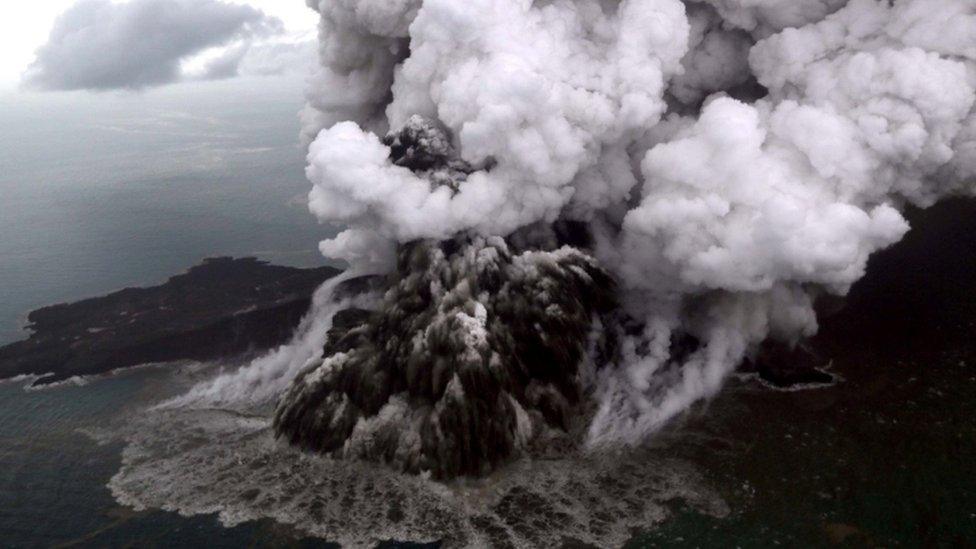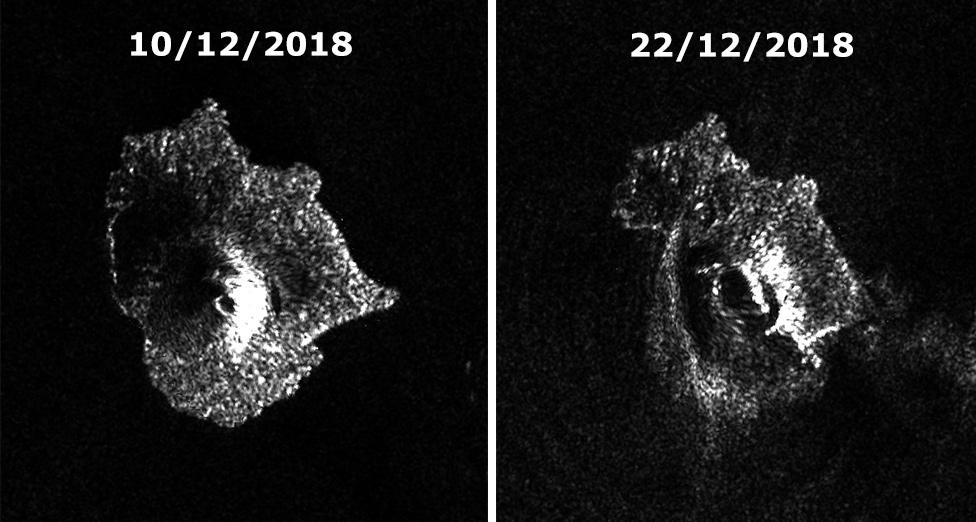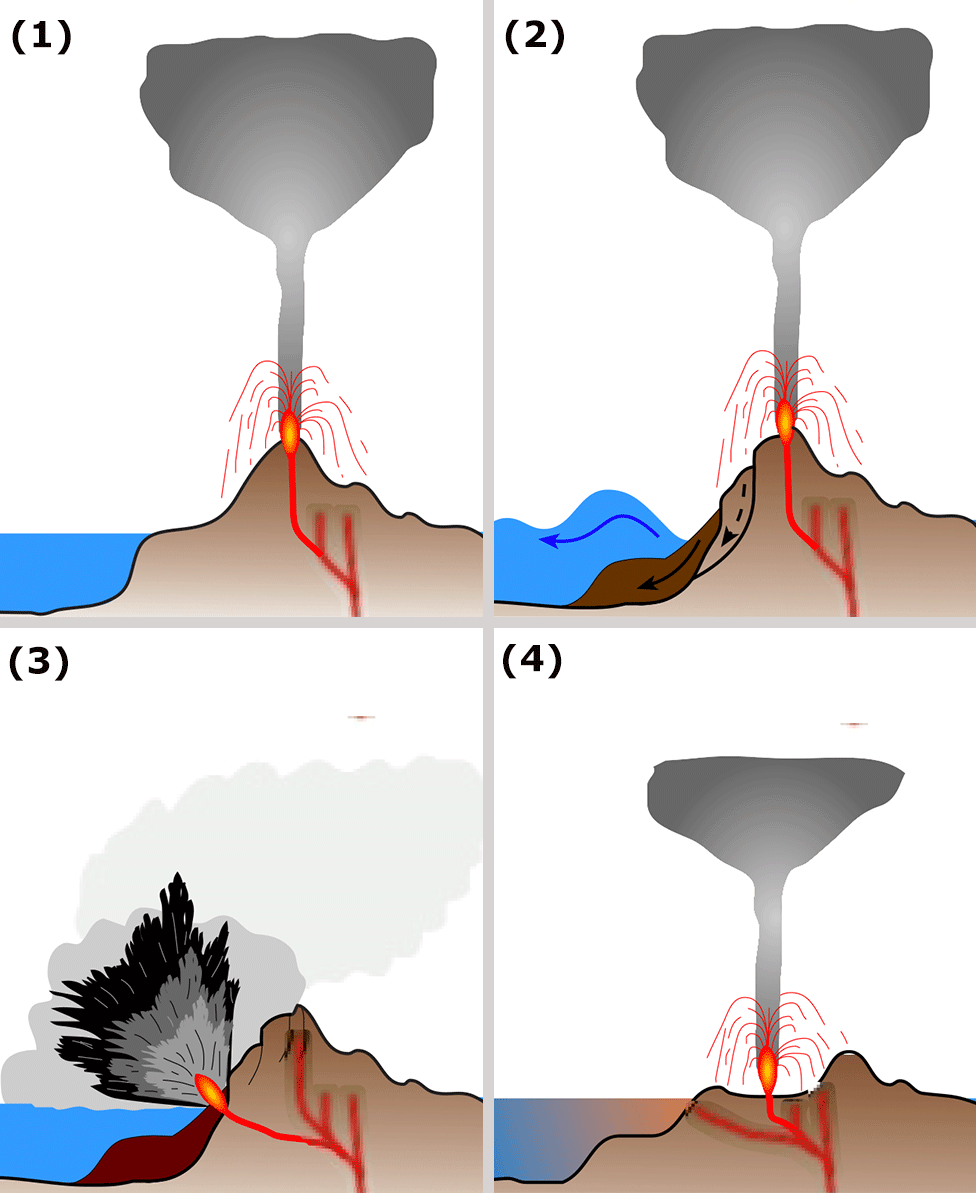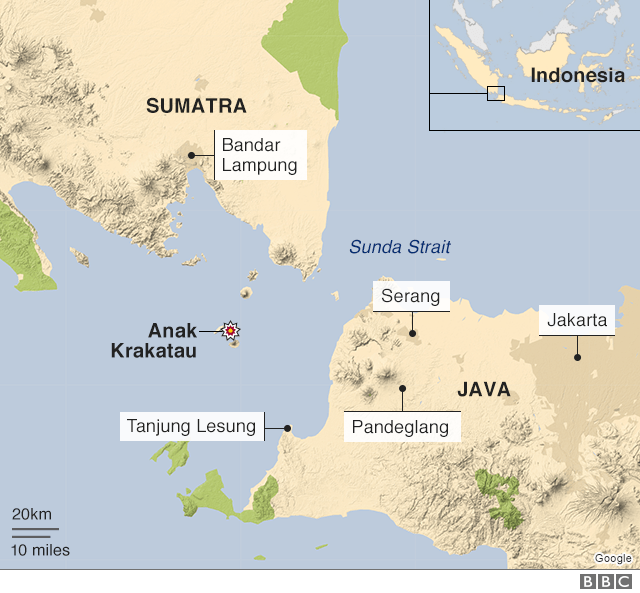Anak Krakatau: Volcano's tsunami trigger was 'relatively small'
- Published

A phreatomagmatic eruption: The volcano's plumbing was reorganised in the flank collapse
The scale of the tsunami hazard from volcanoes that collapse into the sea has been underestimated.
That's the conclusion of a new analysis of satellite pictures of Indonesia's Anak Krakatau showing the aftermath of its flank failure last December.
The study concludes that the volume of material that slipped into the water was actually relatively small.
And yet it generated destructive waves around the Sunda Strait as big as those expected from a much larger event.
More than 400 people died in the disaster on 22 December 2018; a further 7,000 were injured and nearly 47,000 were displaced from their homes.
Rebecca Williams: "We need to be better prepared for these kinds of events"
Rebecca Williams from Hull University, UK, and colleagues have gone back and examined the satellite radar images that were taken of Anak Krakatau ("Child of Krakatau") before, during and after the volcanic activity that precipitated the flank failure.
Radar data was central to the analysis because this remote sensing technique can detect the ground surface even when it's dark, covered by cloud or, as in this case, obscured by erupted ash.

Sentinel-1 helped the team calculate how much of the western flank was lost. Compare these before and after images. The landslide generated the tsunami when it entered the water
A key image in Dr Williams' study is one acquired by the EU's Sentinel-1a satellite which passed over the volcano just eight hours after its western flank had fallen into the water but before the 340m-high mountain's summit had been removed.
It helped her team to not only get a good calculation of the likely volume of lost material in the landslide but to also pick apart the different phases the event went through to produce an edifice that eventually stood little more than 100m above the surrounding ocean.
The estimated slip volume is 0.1 cubic km. This is a third of the volume that had been anticipated would produce the kind of tsunami witnessed on 22 December.
Scientists had modelled in 2012 what might happen if the western flank of Anak Krakatau gave way, and even worked out the likely height and arrival times of waves at nearby coastlines.
These projections turned out to be tragically accurate. However, they had presumed a tsunami-generating mass of 0.3 cu km.
"There's bound to be some error in the detail but we're confident that it was only a very small portion of the flank that collapsed to produce the tsunami," explained Dr Williams.
"The truly dramatic geomorphological (shape) changes we saw coming out a few days later in satellite images were due to the explosive eruption rather than the initial landslide event," she told BBC News.

How Anak Krakatau was remodelled


(1) The volcano had been in a periodic but persistent eruptive phase
(2) On 22 December its western flank failed, generating destructive waves
(3) This opened a vent to the sea. Huge explosions then removed the summit
(4) The volcano began to rebuild itself and closed off the underwater vent

These changes refer to the removal of the summit. The cone and crater are still visible and intact in the Sentinel image. They only disappear in subsequent days.
Dr Williams' team now think the flank collapse may have reorganised the plumbing of the volcano, opening a new vent that brought magma directly into contact with seawater. This would have initiated violent phreatomagmatic activity which is evident in the spectacular photos taken from an aeroplane that flew around Anak Krakatau in late December.
"The behaviour seen in those pictures was very typical of these marine explosions and it's this violence that removed the summit," she explained.
"Over the following weeks, as the volcano started to build again, the water was eventually stopped from getting into the magmatic system and Anak Krakatau went 'back to normal'.
"We went through the old literature and you see evidence of the vents migrating backwards and forwards, so this is something the volcanic island has done throughout its history."

There are about 40 volcanoes worldwide that could do something similar to Anak Krakatau
Dr Williams concedes that many of the tsunami models out there currently cannot reproduce 22 December using a slip volume of only 0.1 cu km, although there is a new simulation from a French group that can, using 0.15 cu km.
"I would challenge that the models are currently underestimating the ability of these landslides to make these larger tsunamis," she said.
It's thought there are about 40 volcanoes worldwide sited close to water that could pose a hazard similar to that of Anak Krakatau.
Dr Williams' group has published its study in the journal Geology, external.


Jonathan.Amos-INTERNET@bbc.co.uk, external and follow me on Twitter: @BBCAmos, external